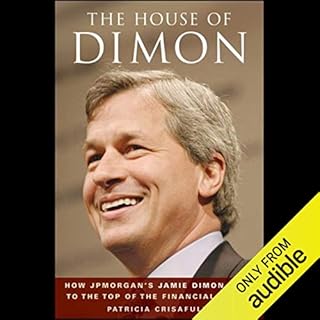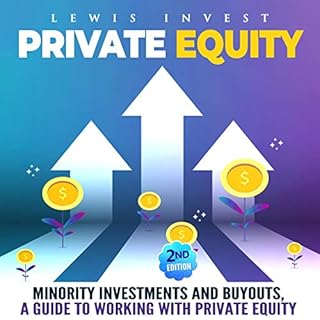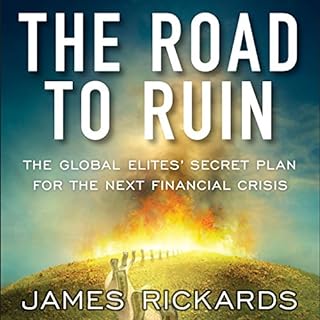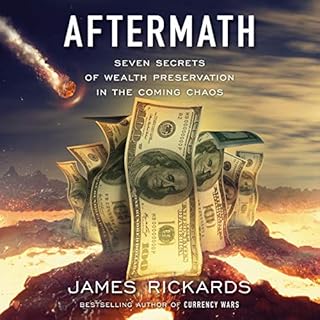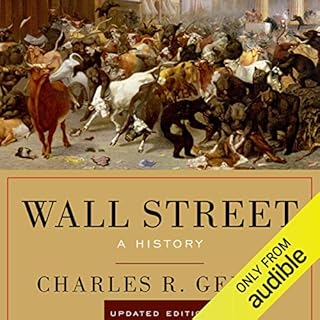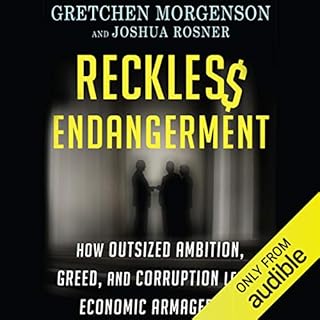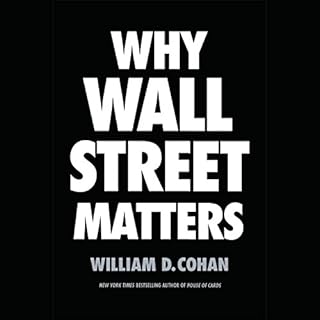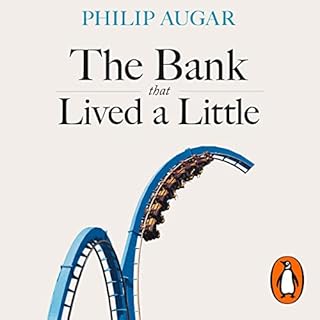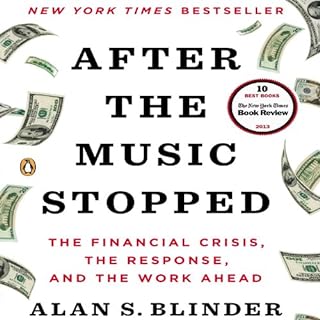
JPMorgan's Fall and Revival
How the Wave of Consolidation Changed America's Premier Bank
No se pudo agregar al carrito
Add to Cart failed.
Error al Agregar a Lista de Deseos.
Error al eliminar de la lista de deseos.
Error al añadir a tu biblioteca
Error al seguir el podcast
Error al dejar de seguir el podcast
 Exclusivo para miembros Prime: ¿Nuevo en Audible? Obtén 2 audiolibros gratis con tu prueba.
Exclusivo para miembros Prime: ¿Nuevo en Audible? Obtén 2 audiolibros gratis con tu prueba.Compra ahora por $17.19
No default payment method selected.
We are sorry. We are not allowed to sell this product with the selected payment method
-
Narrado por:
-
Steve Menasche
Acerca de esta escucha
This book tells the untold story of how JPMorgan became a universal bank in the 1980s-1990s and the events leading to it being acquired by Chase in 2000. It depicts the challenges Morgan's leaders, Lew Preston and Dennis Weatherstone, confronted when the firm's business model was disrupted by the developing country debt crisis, up to its current management with Jamie Dimon.
This firsthand account explores whether Morgan could have stayed independent had its leaders pursued the strategic plan that called for it to make targeted acquisitions in areas where it had well-established businesses. Instead, in the mid-1990s, it went from being the hunter to the hunted. Rival banks that had been burdened by bad loans to developing countries and commercial real estate capitalized on rising share prices during the tech boom to acquire other institutions. Meanwhile, Morgan's profits and share price lagged, which left it vulnerable.
During this time, all of the leading financial institutions struggled to change their business models. In the end, no US money center bank was able to become a universal bank on its own. What ensued was a growing concentration of financial assets in a handful of institutions that was the precursor to the 2008 financial crisis, which is explored further using Morgan as a lens, in this must-listen book.
©2020 Nicholas P. Sargen (P)2020 Gildan MediaLos oyentes también disfrutaron...
-
The House of Dimon
- How JP Morgan's Jamie Dimon Rose to the Top of the Financial World
- De: Patricia Crisafulli
- Narrado por: Suzanne Toren
- Duración: 9 h y 39 m
- Versión completa
-
General4.5 out of 5 stars 146
-
Narración:4.5 out of 5 stars 117
-
Historia4.5 out of 5 stars 117
Jamie Dimon is Wall Street's biggest player. Following the 11h-hour rescue of Bear Stearns by JPMorgan, his profile has reached stratospheric levels. And while the deals and decisions he's made have usually turned out to be the right ones, his journey to the top of the financial world has been anything but easy. Now, in The House of Dimon, business writer Patricia Crisafulli goes behind the scenes to recount the amazing events that have shaped Dimon's career.
-
4 out of 5 stars
-
Intriguing
- De Jean en 08-28-16
-
The House of Morgan
- An American Banking Dynasty and the Rise of Modern Finance
- De: Ron Chernow
- Narrado por: Robertson Dean
- Duración: 34 h y 37 m
- Versión completa
-
General4.5 out of 5 stars 3,347
-
Narración:4.5 out of 5 stars 2,905
-
Historia4.5 out of 5 stars 2,881
A gripping history of banking and the booms and busts that shaped the world on both sides of the Atlantic, The House of Morgan traces the trajectory of the J. P.Morgan empire from its obscure beginnings in Victorian London to the crash of 1987. Ron Chernow paints a fascinating portrait of the private saga of the Morgans and the rarefied world of the American and British elite in which they moved. Based on extensive interviews and access to the family and business archives, The House of Morgan is an investigative masterpiece.
-
4 out of 5 stars
-
The construction of the House of Morgan
- De Darwin8u en 10-22-18
De: Ron Chernow
-
Partisans
- The Conservative Revolutionaries Who Remade American Politics in the 1990s
- De: Nicole Hemmer
- Narrado por: Nicole Hemmer
- Duración: 10 h y 11 m
- Versión completa
-
General5 out of 5 stars 120
-
Narración:4.5 out of 5 stars 105
-
Historia4.5 out of 5 stars 105
A bold new history of modern conservatism that finds its origins in the populist right-wing politics of the 1990s.
-
5 out of 5 stars
-
Great history of the fringe elements of the Republican party that led to Donald Trump!
- De John en 01-24-23
De: Nicole Hemmer
-
Inside Money
- Brown Brothers Harriman and the American Way of Power
- De: Zachary Karabell
- Narrado por: Zachary Karabell
- Duración: 17 h y 16 m
- Versión completa
-
General4.5 out of 5 stars 161
-
Narración:4.5 out of 5 stars 140
-
Historia4.5 out of 5 stars 140
In Inside Money, acclaimed historian, commentator, and former financial executive Zachary Karabell offers the first full and frank look inside this institution against the backdrop of American history. Blessed with complete access to the company's archives, as well as a thrilling understanding of the larger forces at play, Karabell has created an X-ray of American power - financial, political, cultural - as it has evolved from the early 1800s to the present.
-
5 out of 5 stars
-
Brilliant, well researched & highly insightful
- De Mongezi en 02-11-22
De: Zachary Karabell
-
The Bogle Effect
- How John Bogle and Vanguard Turned Wall Street Inside Out and Saved Investors Trillions
- De: Eric Balchunas
- Narrado por: Mike Lenz
- Duración: 10 h y 33 m
- Versión completa
-
General4.5 out of 5 stars 60
-
Narración:4.5 out of 5 stars 47
-
Historia4.5 out of 5 stars 48
The index fund was just one innovation fueled by The Vanguard Group founder Jack Bogle's radical idea in 1975 to make investors the actual owners of his new fund company. The end result was powerful: a fund company for the people and by the people. But Bogle's impact and this "great cost migration" reaches well beyond index funds into many other areas, such as active management, ETFs, the advisory world, quantitative investing, ESG, behavioral finance, and even trading platforms.
-
4 out of 5 stars
-
Important book
- De R. Winchester en 09-09-24
De: Eric Balchunas
-
The Synergy Solution
- How Companies Win the Mergers and Acquisitions Game
- De: Mark Sirower, Jeff Weirens
- Narrado por: Barry Abrams
- Duración: 12 h y 7 m
- Versión completa
-
General4.5 out of 5 stars 5
-
Narración:4.5 out of 5 stars 4
-
Historia4 out of 5 stars 4
The Synergy Solution will change how companies think about and approach their M&A strategies and realize the performance promises they make to their shareholders. Beginning with a clear and well-accepted foundation of the economics of the M&A performance problem, Deloitte's Mark Sirower and Jeff Weirens show acquirers how to develop and execute an M&A strategy-end-to-end-that both avoids the pitfalls that so many companies fall into and creates real, long-term shareholder value.
-
5 out of 5 stars
-
Great refresher even for experienced PMI consultants
- De Sonny Ali en 06-30-22
De: Mark Sirower, y otros
-
The House of Dimon
- How JP Morgan's Jamie Dimon Rose to the Top of the Financial World
- De: Patricia Crisafulli
- Narrado por: Suzanne Toren
- Duración: 9 h y 39 m
- Versión completa
-
General4.5 out of 5 stars 146
-
Narración:4.5 out of 5 stars 117
-
Historia4.5 out of 5 stars 117
Jamie Dimon is Wall Street's biggest player. Following the 11h-hour rescue of Bear Stearns by JPMorgan, his profile has reached stratospheric levels. And while the deals and decisions he's made have usually turned out to be the right ones, his journey to the top of the financial world has been anything but easy. Now, in The House of Dimon, business writer Patricia Crisafulli goes behind the scenes to recount the amazing events that have shaped Dimon's career.
-
4 out of 5 stars
-
Intriguing
- De Jean en 08-28-16
-
The House of Morgan
- An American Banking Dynasty and the Rise of Modern Finance
- De: Ron Chernow
- Narrado por: Robertson Dean
- Duración: 34 h y 37 m
- Versión completa
-
General4.5 out of 5 stars 3,347
-
Narración:4.5 out of 5 stars 2,905
-
Historia4.5 out of 5 stars 2,881
A gripping history of banking and the booms and busts that shaped the world on both sides of the Atlantic, The House of Morgan traces the trajectory of the J. P.Morgan empire from its obscure beginnings in Victorian London to the crash of 1987. Ron Chernow paints a fascinating portrait of the private saga of the Morgans and the rarefied world of the American and British elite in which they moved. Based on extensive interviews and access to the family and business archives, The House of Morgan is an investigative masterpiece.
-
4 out of 5 stars
-
The construction of the House of Morgan
- De Darwin8u en 10-22-18
De: Ron Chernow
-
Partisans
- The Conservative Revolutionaries Who Remade American Politics in the 1990s
- De: Nicole Hemmer
- Narrado por: Nicole Hemmer
- Duración: 10 h y 11 m
- Versión completa
-
General5 out of 5 stars 120
-
Narración:4.5 out of 5 stars 105
-
Historia4.5 out of 5 stars 105
A bold new history of modern conservatism that finds its origins in the populist right-wing politics of the 1990s.
-
5 out of 5 stars
-
Great history of the fringe elements of the Republican party that led to Donald Trump!
- De John en 01-24-23
De: Nicole Hemmer
-
Inside Money
- Brown Brothers Harriman and the American Way of Power
- De: Zachary Karabell
- Narrado por: Zachary Karabell
- Duración: 17 h y 16 m
- Versión completa
-
General4.5 out of 5 stars 161
-
Narración:4.5 out of 5 stars 140
-
Historia4.5 out of 5 stars 140
In Inside Money, acclaimed historian, commentator, and former financial executive Zachary Karabell offers the first full and frank look inside this institution against the backdrop of American history. Blessed with complete access to the company's archives, as well as a thrilling understanding of the larger forces at play, Karabell has created an X-ray of American power - financial, political, cultural - as it has evolved from the early 1800s to the present.
-
5 out of 5 stars
-
Brilliant, well researched & highly insightful
- De Mongezi en 02-11-22
De: Zachary Karabell
-
The Bogle Effect
- How John Bogle and Vanguard Turned Wall Street Inside Out and Saved Investors Trillions
- De: Eric Balchunas
- Narrado por: Mike Lenz
- Duración: 10 h y 33 m
- Versión completa
-
General4.5 out of 5 stars 60
-
Narración:4.5 out of 5 stars 47
-
Historia4.5 out of 5 stars 48
The index fund was just one innovation fueled by The Vanguard Group founder Jack Bogle's radical idea in 1975 to make investors the actual owners of his new fund company. The end result was powerful: a fund company for the people and by the people. But Bogle's impact and this "great cost migration" reaches well beyond index funds into many other areas, such as active management, ETFs, the advisory world, quantitative investing, ESG, behavioral finance, and even trading platforms.
-
4 out of 5 stars
-
Important book
- De R. Winchester en 09-09-24
De: Eric Balchunas
-
The Synergy Solution
- How Companies Win the Mergers and Acquisitions Game
- De: Mark Sirower, Jeff Weirens
- Narrado por: Barry Abrams
- Duración: 12 h y 7 m
- Versión completa
-
General4.5 out of 5 stars 5
-
Narración:4.5 out of 5 stars 4
-
Historia4 out of 5 stars 4
The Synergy Solution will change how companies think about and approach their M&A strategies and realize the performance promises they make to their shareholders. Beginning with a clear and well-accepted foundation of the economics of the M&A performance problem, Deloitte's Mark Sirower and Jeff Weirens show acquirers how to develop and execute an M&A strategy-end-to-end-that both avoids the pitfalls that so many companies fall into and creates real, long-term shareholder value.
-
5 out of 5 stars
-
Great refresher even for experienced PMI consultants
- De Sonny Ali en 06-30-22
De: Mark Sirower, y otros
-
The Outsiders
- Eight Unconventional CEOs and Their Radically Rational Blueprint for Success
- De: William N. Thorndike
- Narrado por: Brian Troxell
- Duración: 5 h y 52 m
- Versión completa
-
General4.5 out of 5 stars 2,676
-
Narración:4.5 out of 5 stars 2,206
-
Historia4.5 out of 5 stars 2,194
In The Outsiders, you'll learn the traits and methods striking for their consistency and relentless rationality that helped these unique leaders achieve such exceptional performance. Humble, unassuming, and often frugal, these "outsiders" shunned Wall Street and the press, and shied away from the hottest new management trends. Instead, they shared specific traits that put them and the companies they led on winning trajectories: a laser-sharp focus on per share value as opposed to earnings or sales growth; an exceptional talent for allocating capital and human resources; and the belief that cash flow, not reported earnings, determines a company's long-term value.
-
4 out of 5 stars
-
Great summary of the 8 CEOs, lessons to learn from
- De Jason S en 09-04-19
-
Private Equity: 2nd Edition
- Minority Investments and Buyouts, a Guide to Working with Private Equity
- De: Lewis Invest
- Narrado por: T.J. Allen
- Duración: 3 h y 31 m
- Versión completa
-
General3.5 out of 5 stars 7
-
Narración:3 out of 5 stars 6
-
Historia3.5 out of 5 stars 6
You will hear a lot about venture capital, debt financing, and much more but most times, private equity is mentioned in passing as one of the ways of raising funds for a business. Nobody talks about how to use private equity to raise money for businesses and nobody talks about how to venture into private equity as an investor. It seems like something that only big monied people can use. But that’s not the case; ordinary people like you and I can invest in private equity firms and make tidy returns on investment.
-
3 out of 5 stars
-
Very hard to listen to
- De Alex en 07-19-20
De: Lewis Invest
-
The Road to Ruin
- The Global Elites' Secret Plan for the Next Financial Crisis
- De: James Rickards
- Narrado por: James Rickards
- Duración: 10 h y 47 m
- Versión completa
-
General4.5 out of 5 stars 1,303
-
Narración:4.5 out of 5 stars 1,162
-
Historia4.5 out of 5 stars 1,154
Since 2014, international monetary agencies have been issuing warnings to a small group of finance ministers, banks, and private equity funds: The US government's cowardly choices not to prosecute J.P. Morgan and its ilk and to bloat the economy with a $4 trillion injection of easy credit are driving us headlong toward a cliff. As Rickards shows in this frightening, meticulously researched book, governments around the world have no compunction about conspiring against their citizens.
-
4 out of 5 stars
-
Same story he's written twice before
- De Richard en 01-17-17
De: James Rickards
-
Aftermath
- Seven Secrets of Wealth Preservation in the Coming Chaos
- De: James Rickards
- Narrado por: James Rickards
- Duración: 10 h y 8 m
- Versión completa
-
General4.5 out of 5 stars 941
-
Narración:4.5 out of 5 stars 814
-
Historia4.5 out of 5 stars 811
What goes up, must come down. As any student of financial history knows, the dizzying heights of the stock market can't continue indefinitely - especially since asset prices have been artificially inflated by investor optimism around the Trump administration, ruinously low interest rates, and the infiltration of behavioral economics into our financial lives. The elites are prepared, but what's the average investor to do?
-
3 out of 5 stars
-
Same old Jim
- De Phoenician en 07-27-19
De: James Rickards
-
Other People's Money
- The Real Business of Finance
- De: John Kay
- Narrado por: Walter Dixon
- Duración: 11 h y 54 m
- Versión completa
-
General4 out of 5 stars 235
-
Narración:4.5 out of 5 stars 184
-
Historia4 out of 5 stars 187
The finance sector of Western economies is too large and attracts too many of the smartest college graduates. Financialization over the past three decades has created a structure that lacks resilience and supports absurd volumes of trading. The finance sector devotes too little attention to the search for new investment opportunities and the stewardship of existing ones, and far too much to secondary-market dealing in existing assets. Regulation has contributed more to the problems than the solutions.
-
5 out of 5 stars
-
Listened twice. Everyone must read this.
- De Tristan en 01-18-16
De: John Kay
-
Stay the Course
- The Story of Vanguard and the Index Revolution
- De: John C. Bogle
- Narrado por: Henry Strozier
- Duración: 11 h y 5 m
- Versión completa
-
General4.5 out of 5 stars 82
-
Narración:4.5 out of 5 stars 72
-
Historia4.5 out of 5 stars 71
The story the Vanguard Group as told by its founder, legendary investor John C. Bogle, Stay the Course traces the history of Vanguard - the largest mutual fund organization on Earth. An engaging blend of company history, investment perspective, and personal memoir, this book provides a fascinating look into the mind of an extraordinary man and the company he created.
-
5 out of 5 stars
-
Surprisingly well-written, but bad narrator
- De Anonymous User en 09-08-20
De: John C. Bogle
-
Makers and Takers
- The Rise of Finance and the Fall of American Business
- De: Rana Foroohar
- Narrado por: Rachel Fulginiti
- Duración: 13 h y 25 m
- Versión completa
-
General4.5 out of 5 stars 497
-
Narración:4.5 out of 5 stars 443
-
Historia4.5 out of 5 stars 440
In looking at the forces that shaped the 2016 presidential election, one thing is clear: Much of the population believes that our economic system is rigged to enrich the privileged elites at the expense of hard-working Americans. This is a belief held equally on both sides of political spectrum, and it seems only to be gaining momentum.
-
5 out of 5 stars
-
Amazing
- De Jared en 06-14-16
De: Rana Foroohar
-
Trillions
- How a Band of Wall Street Renegades Invented the Index Fund and Changed Finance Forever
- De: Robin Wigglesworth
- Narrado por: Christopher Grove
- Duración: 12 h y 3 m
- Versión completa
-
General4.5 out of 5 stars 201
-
Narración:4.5 out of 5 stars 170
-
Historia4.5 out of 5 stars 169
From the Financial Times' global finance correspondent, the incredible true story of the iconoclastic geeks who defied conventional wisdom and endured Wall Street's scorn to launch the index fund revolution, democratizing investing and saving hundreds of billions of dollars in fees that would have otherwise lined fat cats' pockets.
-
5 out of 5 stars
-
REALLY entertaining!!
- De Peter Riley en 12-16-21
-
Predator Nation
- Corporate Criminals, Political Corruption, and the Hijacking of America
- De: Charles H. Ferguson
- Narrado por: Rob Shapiro
- Duración: 13 h y 30 m
- Versión completa
-
General4.5 out of 5 stars 254
-
Narración:4.5 out of 5 stars 219
-
Historia4.5 out of 5 stars 220
Charles H. Ferguson, who electrified the world with his Oscar-winning documentary Inside Job, now explains how a predator elite took over the country, step by step, and he exposes the networks of academic, financial, and political influence, in all recent administrations, that prepared the predators' path to conquest. Over the last several decades, the United States has undergone one of the most radical social and economic transformations in its history.
-
5 out of 5 stars
-
J'accuse!!!
- De Nelson Alexander en 07-25-12
-
VC
- An American History
- De: Tom Nicholas
- Narrado por: Bob Souer
- Duración: 13 h
- Versión completa
-
General4 out of 5 stars 71
-
Narración:4 out of 5 stars 53
-
Historia4.5 out of 5 stars 54
VC tells the riveting story of how the industry arose from the United States' long-running orientation toward entrepreneurship. Venture capital has been driven from the start by the pull of outsized returns through a skewed distribution of payoffs - a faith in low-probability but substantial financial rewards that rarely materialize. Whether the gamble is a whaling voyage setting sail from New Bedford or the newest startup in Silicon Valley, VC is not just a model of finance that has proven difficult to replicate in other countries.
-
3 out of 5 stars
-
Could have been better if it was a shorter book
- De Gaerbear en 12-19-19
De: Tom Nicholas
-
Lights Out
- Pride, Delusion, and the Fall of General Electric
- De: Thomas Gryta, Ted Mann
- Narrado por: James Edward Thomas
- Duración: 13 h y 38 m
- Versión completa
-
General4.5 out of 5 stars 360
-
Narración:4.5 out of 5 stars 294
-
Historia4.5 out of 5 stars 291
Since its founding in 1892, GE has been more than just a corporation. For generations, it was job security, a solidly safe investment, and an elite business education for top managers. GE electrified America, powering everything from lightbulbs to turbines, and became fully integrated into the American societal mindset as few companies ever had. And after two decades of leadership under legendary CEO Jack Welch, GE entered the twenty-first century as America's most valuable corporation. Yet, fewer than two decades later, the GE of old was gone.
-
5 out of 5 stars
-
A GE Middle Manager Enraged to Learn These Things
- De Paul Mullen en 08-18-20
De: Thomas Gryta, y otros
-
The Clash of the Cultures
- Investment vs. Speculation
- De: John C. Bogle, Arthur Levitt - foreword
- Narrado por: Al Kessel
- Duración: 13 h y 11 m
- Versión completa
-
General4.5 out of 5 stars 62
-
Narración:4.5 out of 5 stars 56
-
Historia4 out of 5 stars 53
Provocative and refreshingly candid, this audiobook discusses Mr. Bogle's views on the changing culture in the mutual fund industry, how speculation has invaded our national retirement system, the failure of our institutional money managers to effectively participate in corporate governance, and the need for a federal standard of fiduciary duty.
-
3 out of 5 stars
-
Dry as all Hell
- De Pablo Lema en 09-13-19
De: John C. Bogle, y otros
Relacionado con este tema
-
Other People's Money
- The Real Business of Finance
- De: John Kay
- Narrado por: Walter Dixon
- Duración: 11 h y 54 m
- Versión completa
-
General4 out of 5 stars 235
-
Narración:4.5 out of 5 stars 184
-
Historia4 out of 5 stars 187
The finance sector of Western economies is too large and attracts too many of the smartest college graduates. Financialization over the past three decades has created a structure that lacks resilience and supports absurd volumes of trading. The finance sector devotes too little attention to the search for new investment opportunities and the stewardship of existing ones, and far too much to secondary-market dealing in existing assets. Regulation has contributed more to the problems than the solutions.
-
5 out of 5 stars
-
Listened twice. Everyone must read this.
- De Tristan en 01-18-16
De: John Kay
-
The House of Dimon
- How JP Morgan's Jamie Dimon Rose to the Top of the Financial World
- De: Patricia Crisafulli
- Narrado por: Suzanne Toren
- Duración: 9 h y 39 m
- Versión completa
-
General4.5 out of 5 stars 146
-
Narración:4.5 out of 5 stars 117
-
Historia4.5 out of 5 stars 117
Jamie Dimon is Wall Street's biggest player. Following the 11h-hour rescue of Bear Stearns by JPMorgan, his profile has reached stratospheric levels. And while the deals and decisions he's made have usually turned out to be the right ones, his journey to the top of the financial world has been anything but easy. Now, in The House of Dimon, business writer Patricia Crisafulli goes behind the scenes to recount the amazing events that have shaped Dimon's career.
-
4 out of 5 stars
-
Intriguing
- De Jean en 08-28-16
-
Borrowed Time
- Two Centuries of Booms, Busts, and Bailouts at Citi
- De: James Freeman, Vern McKinley
- Narrado por: Fred Sanders
- Duración: 11 h y 51 m
- Versión completa
-
General4.5 out of 5 stars 41
-
Narración:4.5 out of 5 stars 35
-
Historia4.5 out of 5 stars 34
To save the economy and keep Citi afloat in 2008, the government provided huge infusions of cash through multiple bailouts that frustrated and angered the American public. But, as Wall Street Journal writer James Freeman and financial expert Vern McKinley reveal, the 2008 crisis was just one of many disasters Citi has experienced since its founding more than 200 years ago. In Borrowed Time they reveal Citi’s disturbing history of instability and government support. It’s a story that neither Citi nor Washington wants told.
-
1 out of 5 stars
-
Biased
- De CF en 08-09-19
De: James Freeman, y otros
-
Wall Street
- A History, Updated Edition
- De: Charles R. Geisst
- Narrado por: Stephen McLaughlin
- Duración: 27 h y 28 m
- Versión completa
-
General4 out of 5 stars 120
-
Narración:4 out of 5 stars 107
-
Historia4 out of 5 stars 107
Wall Street is an unending source of legend - and nightmares. It is a universal symbol of both the highest aspirations of economic prosperity and the basest impulses of greed and deception. Charles R. Geisst's Wall Street is at once a chronicle of the street itself - from the days when the wall was merely a defensive barricade built by Peter Stuyvesant - and an engaging economic history of the United States, a tale of profits and losses, enterprising spirits, and key figures that transformed America into the most powerful economy in the world.
-
5 out of 5 stars
-
Many books in one; best linking of stories, eras
- De Philo en 03-23-14
-
Battle for the Soul of Capitalism
- De: John C. Bogle
- Narrado por: Stefan Rudnicki
- Duración: 9 h y 16 m
- Versión resumida
-
General4 out of 5 stars 92
-
Narración:4.5 out of 5 stars 42
-
Historia4.5 out of 5 stars 41
There is no one better qualified to tell us about the failures of the American financial system and the grotesque abuses that have taken place in recent years than John C. Bogle, founder and former chief executive of the Vanguard mutual-fund group. This legendary mutual-fund pioneer has witnessed firsthand the innermost workings of the financial industry for more than 50 years and has set the standards for sound investment strategies and stewardship.
-
4 out of 5 stars
-
Do You Own a Mutual Fund?
- De M. Kettell en 02-02-08
De: John C. Bogle
-
Reckless Endangerment
- How Outsized Ambition, Greed, and Corruption Led to Economic Armageddon
- De: Gretchen Morgenson, Joshua Rosner
- Narrado por: L. J. Ganser
- Duración: 11 h y 57 m
- Versión completa
-
General4 out of 5 stars 155
-
Narración:4 out of 5 stars 130
-
Historia4 out of 5 stars 130
In Reckless Endangerment, Gretchen Morgenson, the star business columnist of The New York Times, exposes how the watchdogs who were supposed to protect the country from financial harm were actually complicit in the actions that finally blew up the American economy.
-
4 out of 5 stars
-
Required reading
- De David en 10-24-11
De: Gretchen Morgenson, y otros
-
Other People's Money
- The Real Business of Finance
- De: John Kay
- Narrado por: Walter Dixon
- Duración: 11 h y 54 m
- Versión completa
-
General4 out of 5 stars 235
-
Narración:4.5 out of 5 stars 184
-
Historia4 out of 5 stars 187
The finance sector of Western economies is too large and attracts too many of the smartest college graduates. Financialization over the past three decades has created a structure that lacks resilience and supports absurd volumes of trading. The finance sector devotes too little attention to the search for new investment opportunities and the stewardship of existing ones, and far too much to secondary-market dealing in existing assets. Regulation has contributed more to the problems than the solutions.
-
5 out of 5 stars
-
Listened twice. Everyone must read this.
- De Tristan en 01-18-16
De: John Kay
-
The House of Dimon
- How JP Morgan's Jamie Dimon Rose to the Top of the Financial World
- De: Patricia Crisafulli
- Narrado por: Suzanne Toren
- Duración: 9 h y 39 m
- Versión completa
-
General4.5 out of 5 stars 146
-
Narración:4.5 out of 5 stars 117
-
Historia4.5 out of 5 stars 117
Jamie Dimon is Wall Street's biggest player. Following the 11h-hour rescue of Bear Stearns by JPMorgan, his profile has reached stratospheric levels. And while the deals and decisions he's made have usually turned out to be the right ones, his journey to the top of the financial world has been anything but easy. Now, in The House of Dimon, business writer Patricia Crisafulli goes behind the scenes to recount the amazing events that have shaped Dimon's career.
-
4 out of 5 stars
-
Intriguing
- De Jean en 08-28-16
-
Borrowed Time
- Two Centuries of Booms, Busts, and Bailouts at Citi
- De: James Freeman, Vern McKinley
- Narrado por: Fred Sanders
- Duración: 11 h y 51 m
- Versión completa
-
General4.5 out of 5 stars 41
-
Narración:4.5 out of 5 stars 35
-
Historia4.5 out of 5 stars 34
To save the economy and keep Citi afloat in 2008, the government provided huge infusions of cash through multiple bailouts that frustrated and angered the American public. But, as Wall Street Journal writer James Freeman and financial expert Vern McKinley reveal, the 2008 crisis was just one of many disasters Citi has experienced since its founding more than 200 years ago. In Borrowed Time they reveal Citi’s disturbing history of instability and government support. It’s a story that neither Citi nor Washington wants told.
-
1 out of 5 stars
-
Biased
- De CF en 08-09-19
De: James Freeman, y otros
-
Wall Street
- A History, Updated Edition
- De: Charles R. Geisst
- Narrado por: Stephen McLaughlin
- Duración: 27 h y 28 m
- Versión completa
-
General4 out of 5 stars 120
-
Narración:4 out of 5 stars 107
-
Historia4 out of 5 stars 107
Wall Street is an unending source of legend - and nightmares. It is a universal symbol of both the highest aspirations of economic prosperity and the basest impulses of greed and deception. Charles R. Geisst's Wall Street is at once a chronicle of the street itself - from the days when the wall was merely a defensive barricade built by Peter Stuyvesant - and an engaging economic history of the United States, a tale of profits and losses, enterprising spirits, and key figures that transformed America into the most powerful economy in the world.
-
5 out of 5 stars
-
Many books in one; best linking of stories, eras
- De Philo en 03-23-14
-
Battle for the Soul of Capitalism
- De: John C. Bogle
- Narrado por: Stefan Rudnicki
- Duración: 9 h y 16 m
- Versión resumida
-
General4 out of 5 stars 92
-
Narración:4.5 out of 5 stars 42
-
Historia4.5 out of 5 stars 41
There is no one better qualified to tell us about the failures of the American financial system and the grotesque abuses that have taken place in recent years than John C. Bogle, founder and former chief executive of the Vanguard mutual-fund group. This legendary mutual-fund pioneer has witnessed firsthand the innermost workings of the financial industry for more than 50 years and has set the standards for sound investment strategies and stewardship.
-
4 out of 5 stars
-
Do You Own a Mutual Fund?
- De M. Kettell en 02-02-08
De: John C. Bogle
-
Reckless Endangerment
- How Outsized Ambition, Greed, and Corruption Led to Economic Armageddon
- De: Gretchen Morgenson, Joshua Rosner
- Narrado por: L. J. Ganser
- Duración: 11 h y 57 m
- Versión completa
-
General4 out of 5 stars 155
-
Narración:4 out of 5 stars 130
-
Historia4 out of 5 stars 130
In Reckless Endangerment, Gretchen Morgenson, the star business columnist of The New York Times, exposes how the watchdogs who were supposed to protect the country from financial harm were actually complicit in the actions that finally blew up the American economy.
-
4 out of 5 stars
-
Required reading
- De David en 10-24-11
De: Gretchen Morgenson, y otros
-
Fault Lines
- How Hidden Fractures Still Threaten the World's Economy
- De: Raghuram Rajan
- Narrado por: Richard Davidson
- Duración: 12 h y 58 m
- Versión completa
-
General4 out of 5 stars 147
-
Narración:4.5 out of 5 stars 79
-
Historia4.5 out of 5 stars 82
Raghuram Rajan was one of the few economists who warned of the global financial crisis before it hit. Now, as the world struggles to recover, it's tempting to blame what happened on just a few greedy bankers who took irrational risks and left the rest of us to foot the bill. In Fault Lines, Rajan argues that serious flaws in the economy are also to blame, and warns that a potentially more devastating crisis awaits us if they aren't fixed.
-
1 out of 5 stars
-
A REAL SNOOZER
- De Frank en 12-02-10
De: Raghuram Rajan
-
A History of the United States in Five Crashes
- Stock Market Meltdowns That Defined a Nation
- De: Scott Nations
- Narrado por: Christopher Grove
- Duración: 12 h y 32 m
- Versión completa
-
General4.5 out of 5 stars 914
-
Narración:4.5 out of 5 stars 782
-
Historia4.5 out of 5 stars 777
In this absorbing, smart, and accessible blend of economic and cultural history in the vein of the works of Michael Lewis and Andrew Ross Sorkin, a financial executive and CNBC contributor examines the five most significant stock market crashes in the United States over the past century, revealing how they have defined the nation today.
-
4 out of 5 stars
-
A solid telling of crucial history
- De Philo en 06-17-17
De: Scott Nations
-
A Brief History of Doom
- Two Hundred Years of Financial Crises (Haney Foundation Series)
- De: Richard Vague
- Narrado por: Kevin Meyer
- Duración: 7 h y 22 m
- Versión completa
-
General4.5 out of 5 stars 49
-
Narración:4.5 out of 5 stars 48
-
Historia4.5 out of 5 stars 48
Financial crises happen time and again in post-industrial economies - and they are extraordinarily damaging. Building on insights gleaned from many years of work in the banking industry and drawing on a vast trove of data, Richard Vague argues that such crises follow a pattern that makes them both predictable and avoidable. A Brief History of Doom examines a series of major crises over the past 200 years in the United States, Great Britain, Germany, France, Japan, and China - including the Great Depression and the economic meltdown of 2008.
-
5 out of 5 stars
-
Great Continuity
- De Anonymous User en 08-24-22
De: Richard Vague
-
Why Wall Street Matters
- De: William D. Cohan
- Narrado por: Rob Shapiro
- Duración: 4 h y 14 m
- Versión completa
-
General4 out of 5 stars 56
-
Narración:4.5 out of 5 stars 50
-
Historia4 out of 5 stars 51
William D. Cohan is no knee-jerk advocate for Wall Street and the big banks. He's one of America's most respected financial journalists and the progressive best-selling author of House of Cards. He has long been critical of the bad behavior that plagued much of Wall Street in the years leading up to the 2008 financial crisis, and because he spent 17 years as an investment banker on Wall Street, he is an expert on its inner workings as well.
-
2 out of 5 stars
-
An Inch Deep and A Mile Wide
- De Doug Sheridan en 04-26-17
De: William D. Cohan
-
Red Flags
- Why Xi's China Is in Jeopardy
- De: George Magnus
- Narrado por: Derek Perkins
- Duración: 9 h y 59 m
- Versión completa
-
General4.5 out of 5 stars 593
-
Narración:4.5 out of 5 stars 491
-
Historia4 out of 5 stars 488
Over the past four decades, China's remarkable transformation has garnered admiration but also sparked concern. George Magnus draws on his intimate knowledge of this dynamic nation to uncover the origins of its ascent and show why the economic traps it faces at home and the political challenges it faces abroad pose a serious threat to its continued rise.
-
4 out of 5 stars
-
A pessimistic vision with western liberal bias
- De Jeronimo L. Jimenez en 10-23-20
De: George Magnus
-
Collusion
- How Central Bankers Rigged the World
- De: Nomi Prins
- Narrado por: Ellen Archer
- Duración: 14 h y 30 m
- Versión completa
-
General4.5 out of 5 stars 300
-
Narración:4.5 out of 5 stars 259
-
Historia4.5 out of 5 stars 257
In this searing exposé, former Wall Street insider Nomi Prins shows how the 2007-2008 financial crisis turbo-boosted the influence of central bankers and triggered a massive shift in the world order. Packed with tantalizing details about the elite players orchestrating the world economy, Collusion takes the listener inside the most discreet conversations at exclusive retreats like Jackson Hole and Davos. A work of meticulous reporting and bracing analysis, Collusion will change the way we understand the new world of international finance.
-
3 out of 5 stars
-
Fair history survey, lazy characterizations
- De Philo en 05-09-18
De: Nomi Prins
-
The Motley Fool Million Dollar Portfolio
- De: David Gardner, Tom Gardner
- Narrado por: David Gardner, Tom Gardner
- Duración: 7 h y 47 m
- Versión completa
-
General4.5 out of 5 stars 105
-
Narración:4.5 out of 5 stars 69
-
Historia4.5 out of 5 stars 69
Listeners are offered a first-class education in building, growing, and defending an individual portfolio, one investment strategy at a time. From learning to think like an investor to finding a first stock, from international investing to community-based online tools, this audiobook takes the reader through the essential strategies for building any portfolio, no matter how small its start or how big its ambitions.
-
4 out of 5 stars
-
Great Introduction to Investing
- De Matthew en 09-18-09
De: David Gardner, y otros
-
Dealing with China
- An Insider Unmasks the New Economic Superpower
- De: Henry M. Paulson
- Narrado por: Kevin Stillwell
- Duración: 18 h y 31 m
- Versión completa
-
General4.5 out of 5 stars 353
-
Narración:4.5 out of 5 stars 314
-
Historia4.5 out of 5 stars 314
When Hu Jintao, China's then vice president, came to visit the New York Stock Exchange and Ground Zero in 2002, he asked Hank Paulson to be his guide. It was a testament to the pivotal role that Goldman Sachs played in helping China experiment with private enterprise. In Dealing with China, the best-selling author of On the Brink draws on his unprecedented access to both the political and business leaders of modern China to answer several key questions.
-
5 out of 5 stars
-
A Valuable Book on China
- De Michael Moore en 09-04-15
De: Henry M. Paulson
-
The Bank That Lived a Little
- Barclays in the Age of the Very Free Market
- De: Philip Augar
- Narrado por: Jonathan Keeble
- Duración: 15 h y 32 m
- Versión completa
-
General4.5 out of 5 stars 34
-
Narración:4.5 out of 5 stars 29
-
Historia4.5 out of 5 stars 28
Based on unparalleled access to those involved, and told with compelling pace and drama, The Bank That Lived a Little is the story of one of the most familiar names on the British high street since Big Bang in 1986. Philip Augar describes in detail three decades of boardroom intrigue driven by ruthless ambition, grandiose dreams and a desire for wealth. It is a tale of a struggle for long-term supremacy between rival strategies and their adherents.
-
5 out of 5 stars
-
Global superstar bankers under light-touch gov
- De Philo en 12-21-18
De: Philip Augar
-
The Manual of Ideas
- The Proven Framework for Finding the Best Value Investments
- De: John Mihaljevic
- Narrado por: Mark Moseley
- Duración: 11 h y 8 m
- Versión completa
-
General4.5 out of 5 stars 273
-
Narración:4.5 out of 5 stars 208
-
Historia4.5 out of 5 stars 211
Considered an indispensable source of cutting-edge research and ideas among the world's top investment firms and money managers, the journal The Manual of Ideas boasts a subscriber list that reads like a Who's Who of high finance. Written by that publication's managing editor and inspired by its mission to serve as an "idea funnel" for the world's top money managers, this book introduces you to a proven, proprietary framework for finding, researching, analyzing, and implementing the best value investing opportunities.
-
5 out of 5 stars
-
Valuable Information
- De Neils en 05-06-15
De: John Mihaljevic
-
The End of Alchemy
- Money, Banking, and the Future of the Global Economy
- De: Mervyn King
- Narrado por: Greg Wagland
- Duración: 14 h y 3 m
- Versión completa
-
General4.5 out of 5 stars 417
-
Narración:4.5 out of 5 stars 346
-
Historia4.5 out of 5 stars 348
Something is wrong with our banking system. We all sense that, but Mervyn King knows it firsthand; his 10 years at the helm of the Bank of England, including at the height of the financial crisis, revealed profound truths about the mechanisms of our capitalist society. In The End of Alchemy, he offers us an essential work about the history and future of money and banking, the keys to modern finance.
-
5 out of 5 stars
-
Two books in one, both very fine
- De Philo en 07-13-16
De: Mervyn King
-
After the Music Stopped
- The Financial Crisis, the Response, and the Work Ahead
- De: Alan S. Blinder
- Narrado por: Graham Vick
- Duración: 15 h y 50 m
- Versión completa
-
General4.5 out of 5 stars 169
-
Narración:4.5 out of 5 stars 149
-
Historia4.5 out of 5 stars 148
Alan S. Blinder - esteemed Princeton professor, Wall Street Journal columnist, and former vice chairman of the Federal Reserve Board under Alan Greenspan - is one of our wisest and most clear-eyed economic thinkers. In After the Music Stopped, he delivers a masterful narrative of how the worst economic crisis in postwar American history happened, what the government did to fight it, and what we must do to recover from it.
-
1 out of 5 stars
-
Irresponsible, corrupt, and confused book
- De Thomas en 12-22-14
De: Alan S. Blinder
Lo que los oyentes dicen sobre JPMorgan's Fall and Revival
Calificaciones medias de los clientesReseñas - Selecciona las pestañas a continuación para cambiar el origen de las reseñas.
-
Total4 out of 5 stars
-
Ejecución5 out of 5 stars
-
Historia4 out of 5 stars
- RB Player
- 01-30-23
A lot of history I didn't know ...
A bit dry at times ... some new information ... but not too much ... covered the history of Chase and banking.
Se ha producido un error. Vuelve a intentarlo dentro de unos minutos.
Has calificado esta reseña.
Reportaste esta reseña
-
Total3 out of 5 stars
-
Ejecución4 out of 5 stars
-
Historia4 out of 5 stars
- Philo
- 11-16-21
Well-thought and expressed history
As a personal memoir, it didn't do much for me. But it put this author, a good chronicler of the events, in a fairly good position to pull all this together. He is a natural writer, having suitably been in a more wonky and word-and-report-generating end of this business. It moves from nuts and bolts inside Morgan (illustrated, I think suitably, with various leadership personalities) to broader contexts of the competitive and regulatory landscape. I was disappointed that some of the larger events were retold (often in quotes) from books I had already read, by Charles Ellis, Roger Lowenstein, etc. But this is not a big gripe. At the end the author got to critiquing Morgan a bit more, which I found effective (after being, I thought, a bit too courteous sometimes earlier). The overall effect, if sometimes a bit collegial and thus sheathed, gives, i think, a pretty balanced account. As a run-through of US big banking history from the late 70s through the early 2000s, it works nicely. It sort of picks up from Chernow's House of Morgan and updates the story. Here we are, post-GFC, and I'm ready for another update already!
Se ha producido un error. Vuelve a intentarlo dentro de unos minutos.
Has calificado esta reseña.
Reportaste esta reseña


